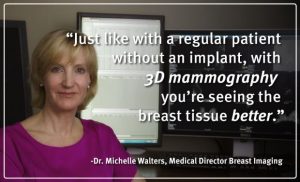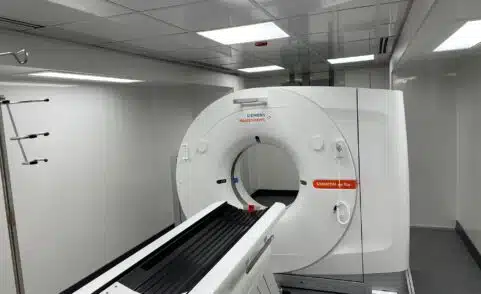
6 Questions to Ask about Breast Implants and Mammograms
If you’re like many women, your decision to get implants came long before your need for a mammogram. The American Society of Plastic Surgeons estimated that half of the women who get breast implants are in their 20′s or early 30′s. The topic of screening mammograms may never have been discussed with your surgeon back then. But if you are nearing or in your 40’s there are questions you should ask because women with breast implants do face different risks.
Am I at higher risk for breast cancer because of my breast implants?
Your risk for breast cancer doesn’t change with implants. The same factors apply to women with and without breast implants: primarily age and family history.
For the record: Studies have shown that neither silicone nor saline implants cause breast cancer. The FDA has reported a link between implants and risk for a type of cancer called Anaplastic Large Cell Lymphoma, but those cases are extremely rare.
How often do I need a mammogram?
Dr. Michelle Walters, Medical Director of Breast Imaging at RAYUS Radiology in Texas, says the mammogram guidelines are the same if you have breast implants. Though there have been conflicting recommended guidelines released in recent years, Dr. Walters says start at 40 and repeat each year. If you have a family history of breast cancer though, you need to start earlier.
Could my implants compromise my mammogram?
According to stopcancerfund.org, breast implants can interfere with the detection of breast cancer by obscuring the mammography image of a tumor and potentially delaying the diagnosis of breast cancer.
The American Cancer Society warns that the X-rays used in mammograms cannot go through silicone or saline implants well enough to show the underlying breast tissue where your radiologist is looking for signs of cancer. This means that the part of the breast tissue covered by the implant won’t be seen on the mammogram.
Your plastic surgeon has the option of putting your implant in front of your pectoralis muscle or behind it. Imaging a breast with an implant in front of the pectoralis muscle can be more complicated because the implant needs to be moved out of the way to get a good view of all the breast tissue during the exam.
That’s when the experience of your mammography technologist comes into play. According to Dr. Walters. “If you have a good tech and if the implant is behind the pectoralis muscle and you move it out of the way, you can see most of the breast tissue very well.”
TIP: When you call to schedule your appointment, make sure to mention you have breast implants so your technologist will know in advance.
Will the mammogram exam damage my implant?
If this question is on your mind, you’re not alone. During a mammogram your breast is compressed. “I’ve had patients come here that are concerned you’re going to pop my implant,” says Dr. Walters. “But we have special views where we can push the implant up out of the way and then we pull the breast in so we’re compressing the breast.” There are other imaging options if the implant can’t be moved enough to X-ray all of the breast tissue. Some patients may need an ultrasound or MRI, both of which can be used to screen for breast cancer.
WATCH: What to Expect from a Breast MRI
Is 3D better than 2D?
In short: Yes. While a traditional 2D mammogram takes 4 images of each breast, a 3D mammogram (also called tomosynthesis) divides the image into one millimeter slices to produce a 3D image of your breast tissue, all in a timespan of just a few more seconds. When a radiologist gets your pictures, they have dozens to look through for each breast compared to just a few from a traditional 2D exam. Getting more images is especially important for women with dense breast tissue. Dr. Walters explains, “Just like with a regular patient without an implant, with 3D mammography you’re seeing the breast tissue better.”
WATCH: Choosing Between 2D and 3D Mammography
Where should I get a mammogram?
Because experience matters, especially for women with breast implants, consider looking for a certified “Breast Imaging Center of Excellence.” That’s an accreditation that’s earned from the American College of Radiology, and it means that center meets the highest standards and requirements to go above and beyond for patients.
Also, look for a facility where you feel comfortable. You’re going to need a mammogram every year for several decades, so find a place where you want to go. Dr. Walters says she makes it a priority to help patients feel like she’s taking good care of them. “We give you that kind of personal attention so you feel comfortable with your healthcare and you feel like you should be coming here for your yearly screenings.”

